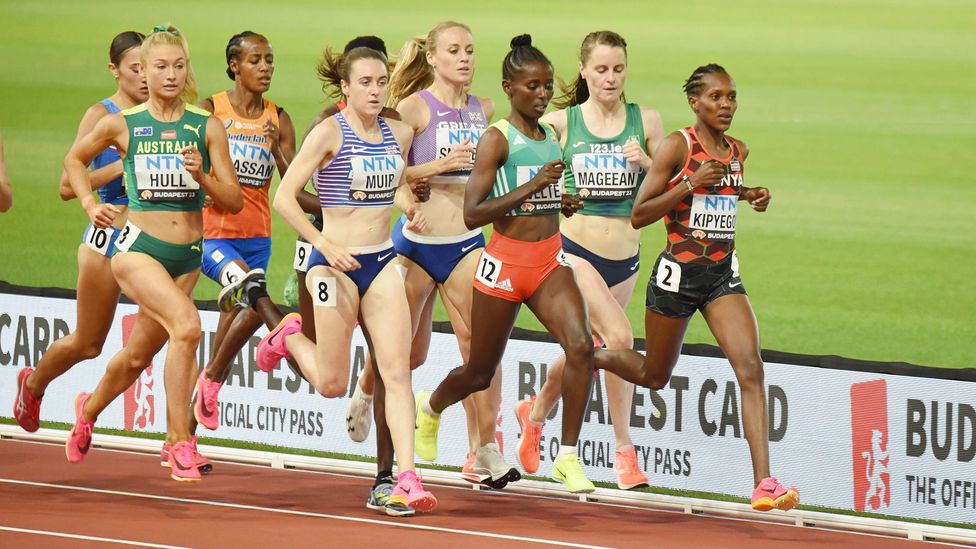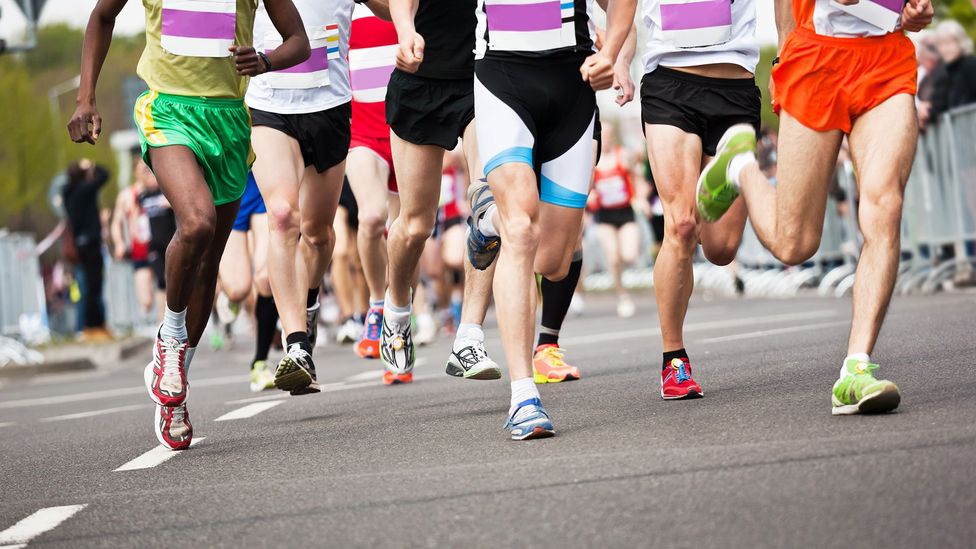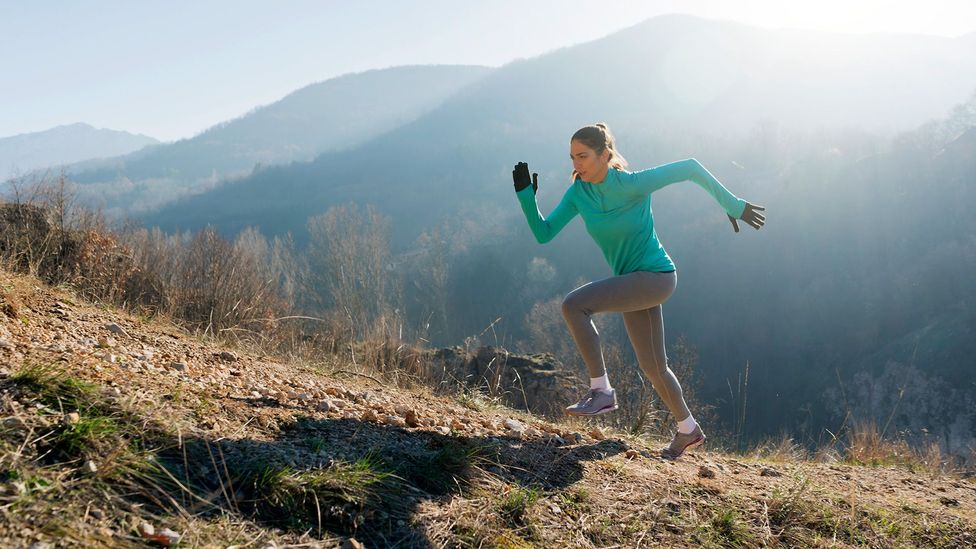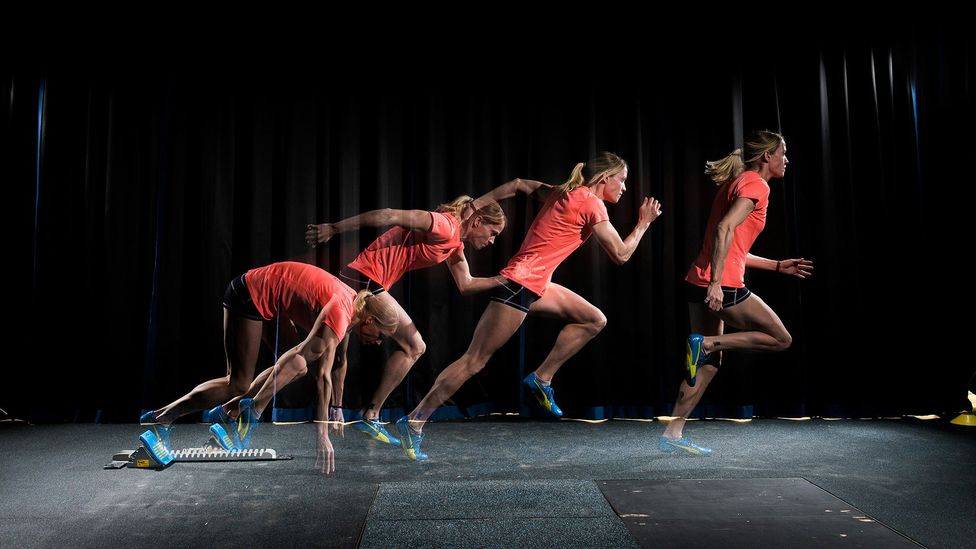Why you might be born to run
Just the rush of wind, a dirt track and my own pounding footsteps. Rain spatters as I splash through puddles and leap over rocks. I feel elated, free and completely at peace. I sprint – just for the hell of it.
Globally, running is one of the most popular and practiced physical activities. In the United States alone, there are around 64 million runners – and it's a similar story the world over. More people than ever are running marathons, with entrants nearly doubling from 2021 to 2022 according to the makers of fitness app Strava. And, in 2023, Parkrun revealed more than 8.5 million runners had registered to take part in its weekly community-led events.
Perhaps, it's the accessibility of running that makes it so appealing. You don't need a gym or (arguably) expensive equipment. You can just chuck on a pair of trainers, step out the door and you're good to go. Easy. Or is it? What distinguishes those people who can run really fast, from those who run at a slower pace? There's increasing evidence that genetics might play an important role.
Ciara Mageean is currently undertaking high altitude training in Flagstaff, Arizona, in preparation for the 2024 Olympics. With a host of successes already under her belt – including silver medals at both the Commonwealth Games and European Championships, fourth place at the World Championships, and Irish records for 800m, 1000m, 1500m and the mile – the 31-year-old recently set a Parkrun world record when she completed the 5k in just 15 minutes 13 seconds. That's less than half the average finish time.
It's 7am. Mageean is about to start her day's training and her positivity, and clear love of running, is infectious. But getting to the top of her sport hasn't been plain sailing.

In 2023, Ciara Mageean just missed out on a medal at the World Athletics Championships in the 1500m but set a new Irish record (Credit: PACE Sports Management)
"I grew up playing a sport called Camogie," she says, "an Irish game like field hockey. I could run all day, so they put me in midfield. But I wouldn't say I was the fastest. Sports day was my favourite day of the year, but I didn't win the all the sprint races."
Mageean's talents lie not in marathon running nor in sprinting, but in middle distance. It was her natural competitiveness that drove her to this discovery.
"I absolutely loved the thrill and adrenaline rush of competing," she says. "I was willing to give everything. I would put myself in a world of pain in order to get out there and be competitive. But, did I always know I was super-fast? No."
Luckily, for Mageean, it turned out she did have a natural ability that would take her to the highest levels of athleticism. "I feel it's impossible to compete at the top level of athletics without having that genetic component," she says.
Scientists have been investigating the existence of a "speed gene" for over two decades now, with increasing evidence that your genetic makeup can have a strong influence on your athletic performance.
There are more than 200 different genetic variations that can influence sports performance and at least 20 that could contribute to someone being an elite athlete. But it is important to point out that these alone will not turn someone into an athlete. In fact, there are many different paths to becoming an elite athlete. When combined with the right training and a myriad of other environmental factors, carrying the right variants of certain genes can give some individuals an edge.
The so-called speed gene, or ACTN3, is a gene that encodes for alpha-actinin-3, a protein expressed only in fast-twitch muscle fibres. Skeletal muscles are made up of hundreds, sometimes thousands, of muscle fibres that are bundled together and wrapped in connective tissue. Each skeletal muscle fibre is a single cylindrical muscle cell and is classified by how fast it contracts. Type I, or "slow-twitch" fibres, are often found in high abundance in elite endurance athletes, such as long-distance runners and cyclists. Meanwhile, type II or "fast-twitch" fibres are abundant in elite power athletes, such as weightlifters and sprinters.
Now, researchers from Exeter University in the UK have taken investigations into the role of genes in athleticism a step further. Sports scientist Henry Chung and his team scrutinised thousands of genes in the DNA from 45 British men and women aged between 20 and 40. For eight weeks, participants ran for 30 minutes, three times a week.
We looked at over 3,000 different genes and found 19 specific genes kept on coming up, all of them related to some sort of fitness variable – Henry Chung
"Over eight weeks, you normally see a 10% improvement in cardio respiratory fitness, or VO2 max – the ability to utilise oxygen as energy – which is the gold standard measurement [of aerobic fitness]," says Chung. "But we noticed a big standard deviation. Some people improved by 20%, some by just 5%. And some didn't improve at all."
Chung's team then conducted a genotype analysis of all the runners. "We looked at over 3,000 different genes," says Chung, "and we found 19 specific genes kept on coming up – all of them related to some sort of fitness variable."
These genes have been reported before, says Chung, but this is the first time a study has linked them together. "The people that improved by around 20% had all 19 of these positive genes, whereas the people that didn't improve much only had one or two," he says.
Of the 19 genes identified, one was the so-called "warrior gene", otherwise known as the monoamine oxidase A gene (MAOA), which is associated with aggression and risk-taking behaviour. "The warrior gene allows you to switch on the survival instinct, to think, 'I need to run, I need to get moving'," says Chung.
However, the study found fewer than 31% of people had the genetic makeup to make the most of training. So, how can you defy genetic expectations?

Advances in training, running surfaces and footwear have led to the dramatic world record progression in running speeds since the first modern Olympics (Credit: Getty Images)
Research shows the dramatic world record progression in running speeds since the first modern Olympics has been driven by advances in training methodology, combined with improvements in running surfaces and footwear. Plus experts say that, with training, you might just be able to change your muscle fibres from slow- to fast-twitch. Perhaps there is hope for those of us who may be speed-challenged.
"Being able to run fast is actually really simple," says Steffi Colyer, an expert in biomechanics at the University of Bath, UK. "You just have to be able to apply really large forces in relation to your own body weight to the ground rapidly. If you want to run faster, you simply need to be able to apply more force to the ground."
However, she adds, the mechanical demands of sprinting change "quite dramatically" as you progress. "We talk about sprinting in terms of an acceleration phase, and then a maximum velocity phase," she says.
Acceleration is at its highest at the very start, and decreases as you go through the race, she explains. As velocity increases, the time that you have in contact with the ground also decreases. So, your opportunity to apply force decreases – to the point where the contact time is so short that you can't generate the necessary forces to continue to accelerate, and you reach maximum velocity. "Then you hold on for dear life to maintain that speed. Usually, in a 100m (328ft) all-out race, you will see a small deceleration phase at the end as well."
To maintain your maximum velocity for as long as possible, says Colyer, you need to activate your muscles – to contract and generate force – in a coordinated way. So, it's a combination of strength, power and technique.
You might also like:
- What's the best time of the day to exercise?
- Why walking backwards can be good for your health and brain
- Protein powders: Are they bad for your health?
Colyer says your foot should make contact with the ground underneath your body, rather than in front, as this will help reduce the breaking force of hitting the ground. Minimising contact with the ground can save you energy, and rapid recovery of your foot when it leaves the ground will also help. "You don't want to have too much going on in the swing phase," she says. "You want to recover your leg through as quickly as possible." Plus, she adds, coordinating the oscillation of your thighs is also important. "To be able to rapidly accelerate your thigh down and back into the ground, is associated with higher force production too."
To a recreational runner like myself, this all sounds a little easier said than done. So, how can it translate into actual training?
"There are so many things you can do," says Mageean. "Whenever I run, I give myself little cues. [I think] 'tap, tap, tap, tap, tap' in my head – because touching the ground super fast and getting my leg back up is going help me run fast."
Mageean advises adding hill workouts into your training. "I really enjoy short, sharp hill strides – for no longer than 10 seconds. Try to run up that hill as fast as you can. Walk back down to the bottom of the hill, fully recover, then go again."
While you're doing it, concentrate on your form, says Mageean. "I imagine somebody's got a string attached to my chest, and they're pulling it up at a 45 degree angle going forward, and that's pulling me up the hill. I try to stay nice and tall, with my arms moving side by side, and with a good triple extension through my feet. So, my foot touches the ground and my leg extends and my hip extends. Then I swing my leg back through as fast as I can. I find those drills really helpful."

Adding hill workouts into your training, says Ciara Mageean, can help improve your speed (Credit: Getty Images)
Mageean also advises varying your speed, so add in some tempo work "just below your race pace", flat strides to incorporate some speed at the end of a long run or break up a run with a fartlek session. "Fartlek, " says Mageean, "is where you run for say three minutes [fast], one minute [slow], and repeat. As they're short reps, you can go slightly faster."
"These are the types of training sessions that I do that really help me improve," she says. "To get faster, you want to increase your aerobic ability – so that at the end, you can sprint home."
For me, running doesn't come particularly easily. My 5km (3.1mile) time has remained roughly the same, at around 30 minutes, for some months now – but ultimately does speed really matter? There are so many more benefits to running than simply watching the clock. Running is good for your heart and your bones. It can improve your mental health, and help you live longer. In fact, research shows that "slow running" could even be more beneficial than fast, reducing the risk of injury, and helping to increase your VO2 max and ultimately your speed.
And Mageean pays tribute to those who don't have that innate ability, but who have the discipline to train. "I know so many talented athletes who have the genetic components, but just don't have the mentality to stay in the sport. Which is really tough to see," she says. "So, I have so much respect for those who maybe aren't as lucky with what they were born with, but really strive to get the absolute best out of themselves."
On the other hand, adds Chung, "if you've got the genes and you work hard, you could be unstoppable".
You never know unless you try. Sprint anyone?
--
If you liked this story, sign up for The Essential List newsletter – a handpicked selection of features, videos and can't-miss news delivered to your inbox every Friday.
Join one million Future fans by liking us on Facebook, or follow us on Twitter or Instagram.
